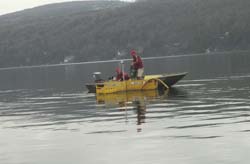Professor Shikha Nangia Named as the Milton and Ann Stevenson Endowed Professor of Biomedical and Chemical Engineering
The College of Engineering and Computer Science (ECS) has announced the appointment of Shikha Nangia as the Milton and Ann Stevenson Endowed Professor of Biomedical and Chemical Engineering. Made possible by a gift from the late Milton and Ann Stevenson,…


 This research has shown the importance of utilizing innovative technology to manage and monitor complex aquatic ecosystems in urban settings. Oftentimes, programs for treating water systems are implemented without robust data to identify the true source of the problem. The value of this case study comes from the large number of cause-and-effect relationships that were clearly identified through the monitoring system.
This research has shown the importance of utilizing innovative technology to manage and monitor complex aquatic ecosystems in urban settings. Oftentimes, programs for treating water systems are implemented without robust data to identify the true source of the problem. The value of this case study comes from the large number of cause-and-effect relationships that were clearly identified through the monitoring system.